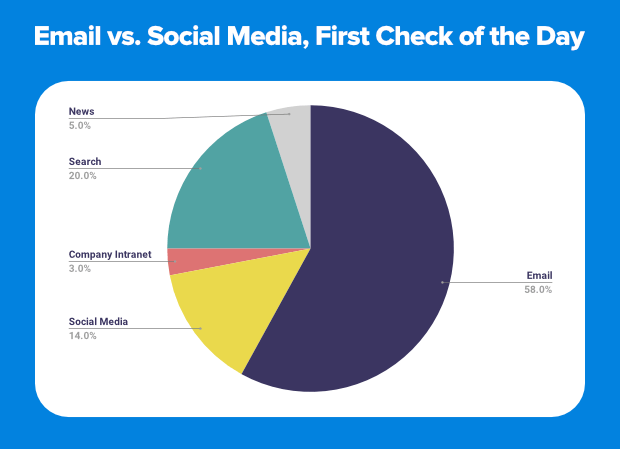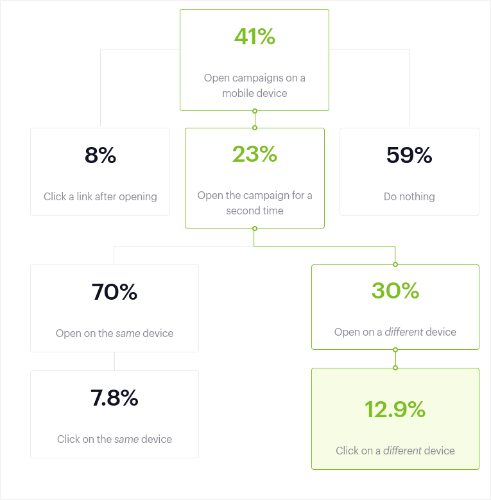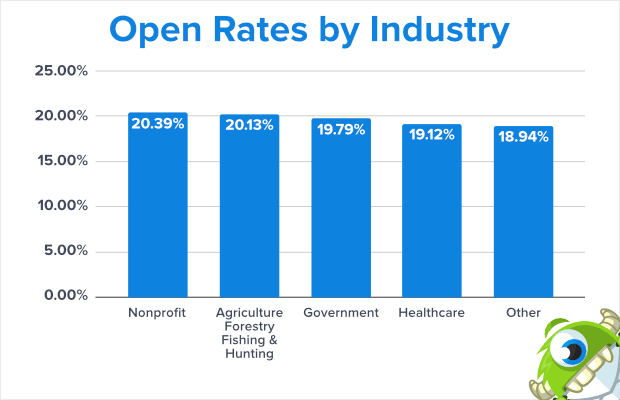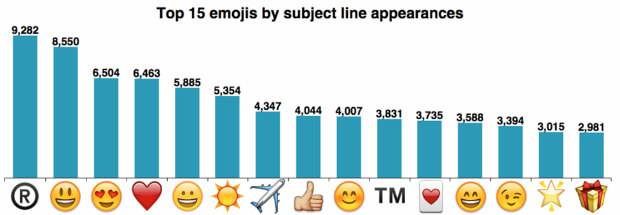Do you know the most recent email marketing statistics?
Everyone is aware of the significant return on investment (ROI) email marketing has compared to other channels, but with limited resources, you want to be sure you’re spending your time and money on the correct marketing strategies. Knowing these email marketing statistic may help you.
One of those “right strategies” that companies of all sizes should engage in is email marketing.
But just in case you’re not sure you’ll see a return on investment from email marketing, we’ve gathered a long list of email marketing data that will astound you.
We’ll share the most recent email marketing data in this article to help you advance your email marketing campaigns.
Let’s get going.
Email Marketing Statistics
Since there are numerous data regarding email marketing in this post, here’s a table of contents to guide you through each part:
- Email Usage Statistics
- Mobile Email Marketing Statistics
- B2B Email Marketing Statistics
- B2C Email Marketing Statistics
- Email Marketing Statistics by Industry
- Personalized Email Marketing Statistics
- Email Engagement Statistics
- The Benefits of Email Marketing
Email Usage Statistics
First, let’s take a look at some basic email marketing statistics on email usage.
One of the biggest benefits of using email to communicate with your customers is that nearly everyone uses email. In fact, 92% of online adults use email, with 61% using it on an average day.
And more and more people are using it year-after-year. The number of email users in the US was projected to grow to 251.8 million by 2020.
Plus, nearly 105 billion emails are sent each day; this number is expected to reach 246 billion.
People aren’t just using email to connect with family and friends either. 61% of consumers prefer to be contacted by brands through email, which is good news for your business.
Even better news? 99% of email users check their email every day, some as much as 20 times a day!
It’s often the first thing people do online; 58% of users check their email before they check out social media or the news.

Users are able to check their emails often—and from anywhere—thanks to mobile phones.
So, let’s take a look at some mobile email marketing statistics in the next section.
Mobile Email Marketing Statistics
Statistics for Mobile Email Marketing
Mobile devices undoubtedly accounted for at least 50% of all read emails because using devices like smartphones and tablets makes it incredibly simple for users to check their inboxes while on the go.
Mobile email checking is particularly popular among younger audiences.40% of people under the age of 18 always read emails first on their mobile devices.
A staggering 81% of people prefer to read emails on their smartphones, while only 21% do so on tablets, when it comes to their preferred mobile devices. When it comes to mobile gadgets, smartphones dominate the field.
But just because users read their emails on smartphones doesn’t mean they don’t also check them on desktop computers. Actually, 23% of consumers who open an email on a mobile device will open that email again later, many times on desktop:

If an email is read on mobile and then read for a second time on desktop, that consumer has a 65% higher likelihood of clicking through.
As you can see, it’s important to make sure your emails are optimized for mobile since that’s how a ton of people check their email inboxes.
42.3% of people will delete an email if it’s not optimized for mobile. So, if your email marketing campaigns aren’t mobile-friendly, all of your hard work will go to waste.
Luckily, most email marketing services like Constant Contact and Sendinblue offer responsive email templates that will make your email messages look great on any screen.
In addition, with an email marketing service, you can automate your email marketing.
Email automation is a must-have for businesses because it not only saves you time, but it makes you more money. 320% more revenue is driven from automated emails than non-automated emails!
Now let’s look at the differences between B2B email marketing and B2C email marketing.
B2B Email Marketing Statistics
Email marketing is one of the most powerful tools for B2B businesses to generate more leads and sales. So much so, that 40% of B2B marketers say email marketing is a tactic that is critical to their success.
With email marketing, B2B businesses can send content to subscribers to educate them about their product/service and convert leads into customers.
77% of B2B companies use an email marketing newsletter as part of their content marketing strategy and 79% of B2B marketers find email to be the most successful channel for content distribution.
In addition, B2B marketing emails see a 23% higher click-to-open ratio than B2C emails!
You can see why 59% of B2B marketers cite email as their top channel for revenue generation.
B2C Email Marketing Statistics
Email marketing also works wonders for B2C businesses; it can turn window shoppers into buyers, boost engagement, improve customer loyalty and retention, and more.
And the statistics prove it!
59% of respondents say marketing emails influence their purchase decisions and 80% of business professionals believe that email marketing increases customer retention.
Email marketing is especially important for eCommerce businesses. 42.3% of Americans subscribe to email lists to receive savings and discounts and roughly 1 in 3 US retail email list subscribers have purchased something from the brand whose emails they receive.
An abandoned cart email strategy is also necessary for eCommerce stores that want to win back sales.
According to statistics, 60% of shoppers returned to complete their purchase after receiving a personalized abandoned cart email, and around 75% of shoppers planned to come back later.
Email Marketing Statistics by Industry
49% of businesses use some form of email automation. But, let’s find out which specific industries get the biggest benefits of email marketing.
According to statistics from Campaign Monitor, the industries with the highest open rates are nonprofit (20.39%), agriculture, fishing, forestry, and hunting (20.13%), government (19.79%), and healthcare services (19.12%).

Similarly, the industries with the top click-to-open rates are agriculture, forestry, fishing and hunting, media, entertainment and publishing, and real estate and design and construction activities.
Some of the industries with the lowest open rates include food and beverage, consumer packaged goods, and retail.
But, don’t worry, you can increase your email open rates and click-to-open rates. One of the ways you can do it is by sending personalized emails.
Keep reading to discover the magic of personalization.
Personalized Email Marketing Statistics
Consumers love getting messages and offers that are personalized to their needs and interests.
In fact, 74% of people hate being shown irrelevant content, which makes personalization incredibly important to a great email marketing strategy.
So, to delight customers and create messages that are more relevant to them, 77% of marketers say they use email to send personalized content to their subscribers.
You can personalize your emails in a number of ways. For instance, many marketers personalize emails based on their demographics like gender and age; 66% of marketers personalize their emails based on age data.
You can also create personalized email marketing campaigns based on previous purchase activity or specific actions the user has taken.
For example, Netflix sends emails to its customers based on TV shows and movies they’ve watched and loved.
Personalized emails like these deliver 6x higher transaction rates!
It’s not just about the content or the body of your email either.
You should also personalize your email subject lines. Emails with personalized subject lines get a 26% boost in open rates.
When your emails are personalized to each user, they’ll be more likely to take action and engage with your emails.
Email Engagement Statistics
Aside from personalization, let’s find out what other factors make users want to engage with your emails.
First and most importantly, the subject line. The email subject line is the first thing that users see and it’s what helps them make the decision whether to open your email or delete it. In fact, 47% of email recipients will open your email based solely on the subject line.
First impressions are important, right?
So, you’ve got to grab the attention of users with your subject line. Many email marketers do this with emojis.
A study by Experian found that email subject lines with an emoji increased open rates by 56%, as compared to text-only subject lines.
Check out the top used emojis in subject lines according to Mailchimp:

Once you get your subscribers to open your emails with awesome subject lines, you’re golden!
As long as your content is relevant and you have a clear call to action, subscribers will take your desired action.
How do we know?
Well, email subscribers are 3.9x more likely to share your content on social media and 4.24% of visitors from email marketing buy something, compared to 2.49% of visitors from search engines and 0.59% from social media.
Be careful, though. Too many emails can cost you subscribers.
The top 3 reasons why people choose to unsubscribe from an email list are too many emails (59%), info no longer relevant (43%), or don’t recognize the brand or remember signing up (43%).
The Benefits of Email Marketing
Wondering if email marketing is really worth it?
For the finale of this big list of email marketing stats, let’s go over some email marketing conversion statistics and email ROI statistics to show you the true benefits of email marketing.
Globally, 30% of marketers cite email marketing as having the highest email marketing ROI. This is probably because, for every $1 spent on email marketing, $44 is made in return, according to a study by Campaign Monitor, which equals a 4400% ROI.
Here are some more email marketing success statistics you can swoon over:
- 18% of companies achieve email marketing ROI greater than $70 per $1 invested.
- Email is 40x more effective at acquiring customers than Facebook and Twitter combined.
- Shoppers spend 138% more when marketed through email, as compared to those who do not receive email offers.
And that’s a wrap!
We hope these email marketing statistics will help you supercharge your emails!
See this article – Install SPF record in 4 easy Steps